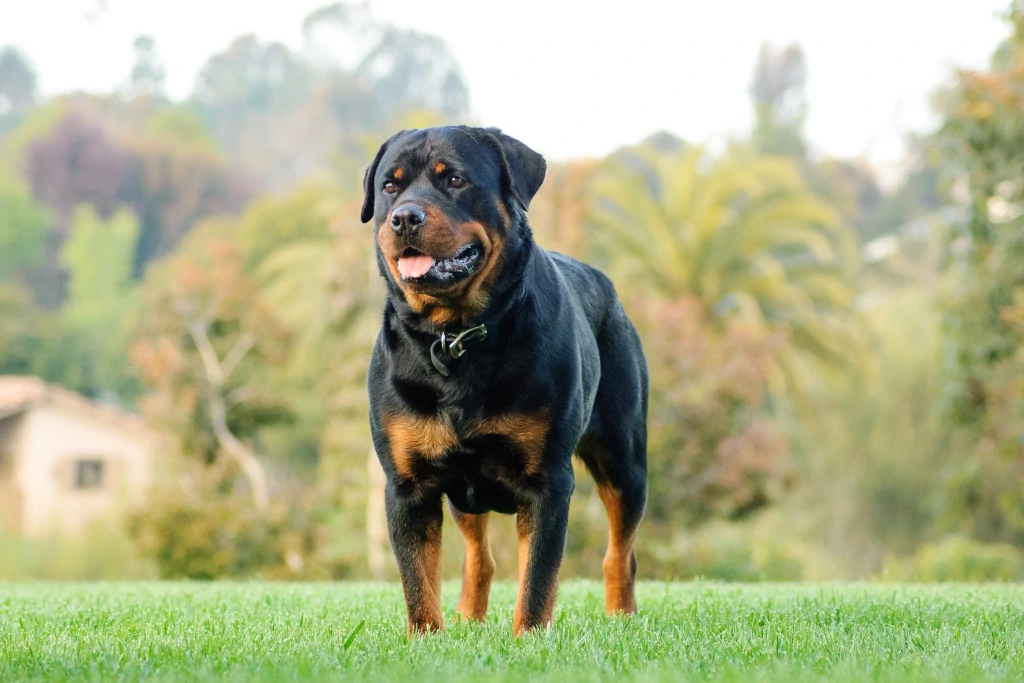
In the realm of dog breeds, the Rottweiler stands as a testament to loyalty, strength, and intelligence. Hailing from the Roman Empire days, these robust canines have always been more than mere pets; they’ve been workers, guardians, and cherished family members.
Yet, as with many breeds that traverse continents, subtle variations arise over generations due to different breeding standards and environmental adaptations. Among Rottweilers, a frequently debated topic is the distinction between the German and American variants.
Both emanate from the same foundational lineage but have developed distinct characteristics that cater to diverse preferences and purposes.
This article explores these nuances, diving deep into their histories, temperaments, and physical traits, offering a comprehensive guide for those looking to unravel the mystery behind the German Rottweiler vs. American Rottweiler debate.
Whether you’re a prospective Rottweiler owner or a seasoned enthusiast, this exploration promises to broaden your understanding and appreciation of this magnificent breed.
Historical Background
The lineage of the Rottweiler traces back to the Roman Empire. These early ancestors of the modern Rottweiler were primarily used by Roman legions to herd cattle, a food source they brought along during their expansive conquests. As the legions ventured into Europe, these dogs played an instrumental role in guarding Roman camps and driving cattle.
By the Middle Ages, these dogs found a prominent place in the German town of Rottweil, a trading hub renowned for its butcher shops. The dogs thrived here, evolving both in their physical stature and roles.
They became aptly known as “Rottweiler Metzgerhund,” which translates to ‘Rottweil Butcher’s Dog‘. Their responsibility encompassed herding livestock and pulling carts laden with butchered meat to market, as well as protecting the butchers and their money pouches from potential thieves. This robust, hardworking demeanor soon made them indispensable to local butchers.
However, as modern transportation and railways emerged, the need for these dogs in their traditional roles waned. Yet, their loyalty, intelligence, and protective instincts did not go unnoticed. By the early 20th century, Rottweilers were being employed in various roles such as police, search and rescue, and even as guide dogs.
The breed’s voyage to America led to its gradual divergence from its German counterpart. The American Kennel Club recognized the Rottweiler in 1931, and from that point, breeding standards in the U.S. began to shift, adjusting to the preferences of American dog enthusiasts and breeders.
While the core essence of the Rottweiler remained intact, specific attributes like size and temperament began to differ.
Today, the German and American Rottweilers, though sharing a common ancestry and many similar traits, bear unique differences that stem from generations of distinct breeding practices and environmental adaptations. Their intertwined yet separate histories form a rich tapestry that paints a picture of resilience, adaptability, and enduring charm.
Physical Differences: American Rottweiler vs. German Rottweiler
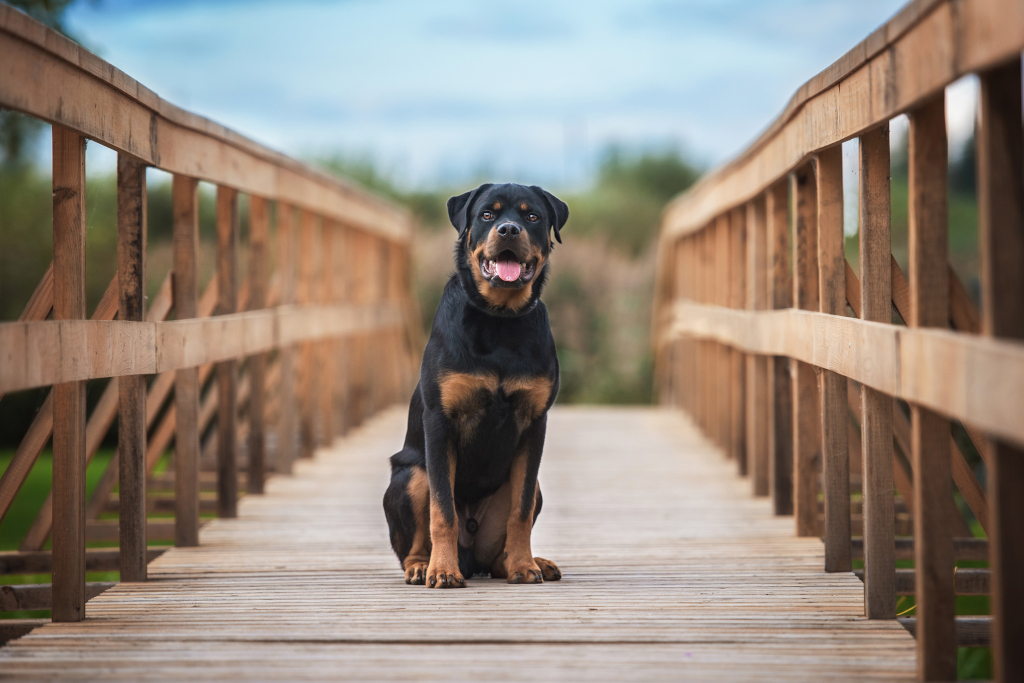
At first glance, German and American Rottweilers may seem identical, but as any seasoned owner or breeder will tell you, subtle distinctions set them apart. Let’s uncover these physical differences.
1. Size and Build
Both American and German Rottweilers usually tip the scales between 80 and 135 pounds and stand at a height ranging from 22 to 27 inches.
- German Rottweiler:
Despite the similarities in average size, both the male German Rottweiler and female German Rottweiler typically lean towards the higher end of the scale. They possess a broader build characterized by a commanding presence, robust muscles, and a notably robust snout. - American Rottweiler:
On the other hand, American variants often display a more athletic physique, appearing leaner and more streamlined.
2. Coat Type and Color
- Coat Type:
The outer coat for both the American and German Rottweiler is straight, dense, and of medium length, lying flat to the body. The undercoat is unnoticeable, hiding beneath the outer layer. - Color Variations:
The coloration for both is predominantly a dark base with iconic tan markings gracing their cheeks, muzzle, throat, chest, legs, and above the eyes.
However, the Allgemeiner Deutscher Rottweiler Klub (ADRK) in Germany strictly accepts only black and tan coloration.
The American Kennel Club (AKC), by contrast, is more lenient, allowing not only black and tan but also black with rust or mahogany markings.
3. Distinct Features
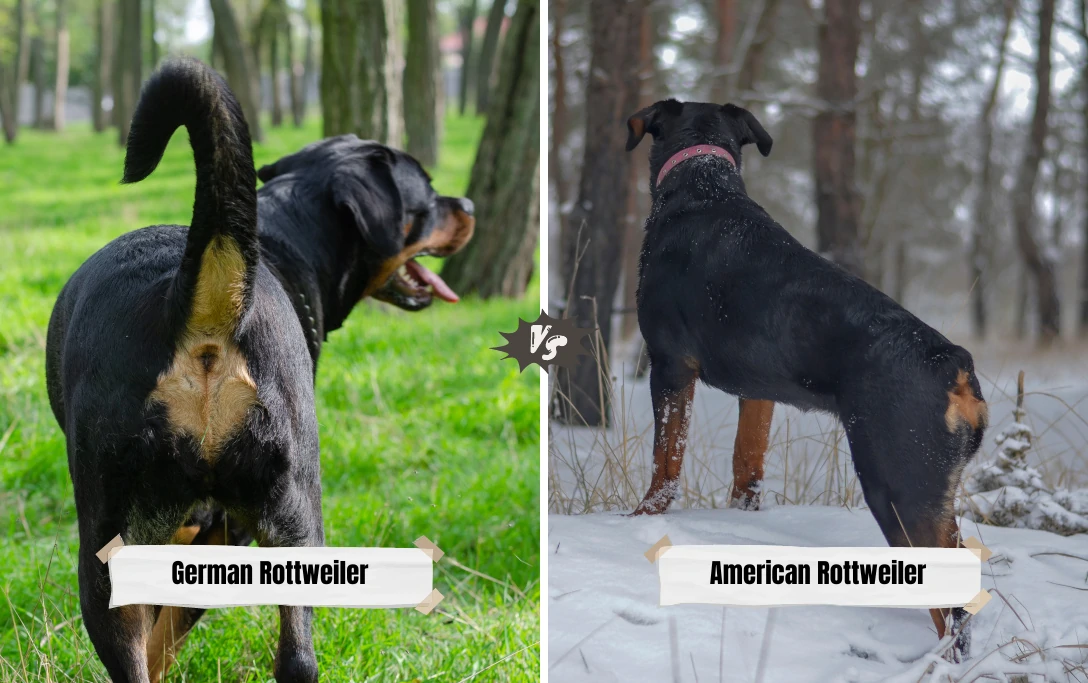
- German Rottweiler:
One of the significant differentiators is the tail. In Germany, tail docking was outlawed, which means German Rotties have their natural tails. - American Rottweiler:
Historically, many American Rottweilers had docked tails, though this practice is decreasing due to changing views on cosmetic alterations.
| Key Differences | German Rottweiler | American Rottweiler |
|---|---|---|
| Size and Build | Bulkier, broader body | Athletic, streamlined |
| Coat Color | Limited to black and tan | Black and tan, black and rust, black and mahogany |
| Tail | Natural, undocked | Can be docked or undocked |
** Comparison Table for Appearance
Temperament and Personality: German vs. American Rottweiler
Though both German and American Rottweilers share the breed’s hallmark traits of loyalty, intelligence, and protectiveness, subtle variations in temperament and behavior distinguish the two. These nuances often emanate from their distinct breeding objectives and roles in society.
German Rottweiler
- Focused and Driven: German Rottweilers are typically bred for work, be it herding, guarding, or service roles. This gives them a heightened sense of purpose and often makes them more focused on tasks.
- Calm and Intelligent: German Rottweilers are recognized for their calm disposition and keen intellect. This makes them highly trainable and able to excel in various working roles.
- Reliability and Loyalty: These dogs are the epitome of reliability, demonstrating steadfast loyalty to their families. This trustworthiness makes them excellent guardians.
- Protective Yet Obedient: While they possess a natural instinct to protect, their obedience training typically ensures that this protectiveness doesn’t escalate into aggression.
You May Also Like: Discover the 10 Top Guard Dogs
American Rottweiler
- Versatile Companions: American Rottweilers are often bred with a broader range of roles in mind, including companionship. This often makes them more adaptable to different lifestyles and family types.
- Playful: These dogs have a zest for life, making them more inclined to engage in playful activities, often making them favorites among children.
- Friendly Disposition: American Rotties are usually more receptive to strangers, particularly if socialized from a young age, while still being protective when needed.
| Key Differences | German Rottweiler | American Rottweiler |
|---|---|---|
| Disposition | Calm, sharp-minded, focused, and task-oriented | Friendlier and more playful and outgoing |
| Aloof with strangers | More reserved | Reserved but not to the same extent as German Rottweilers |
| Loyalty and Reliability | Exceptional | High |
| Protective Instinct | High, but obedient | High, but adaptable |
** Comparison Table for Temperament and Personality
Energy Level and Exercise Needs: American vs. German Rottweiler
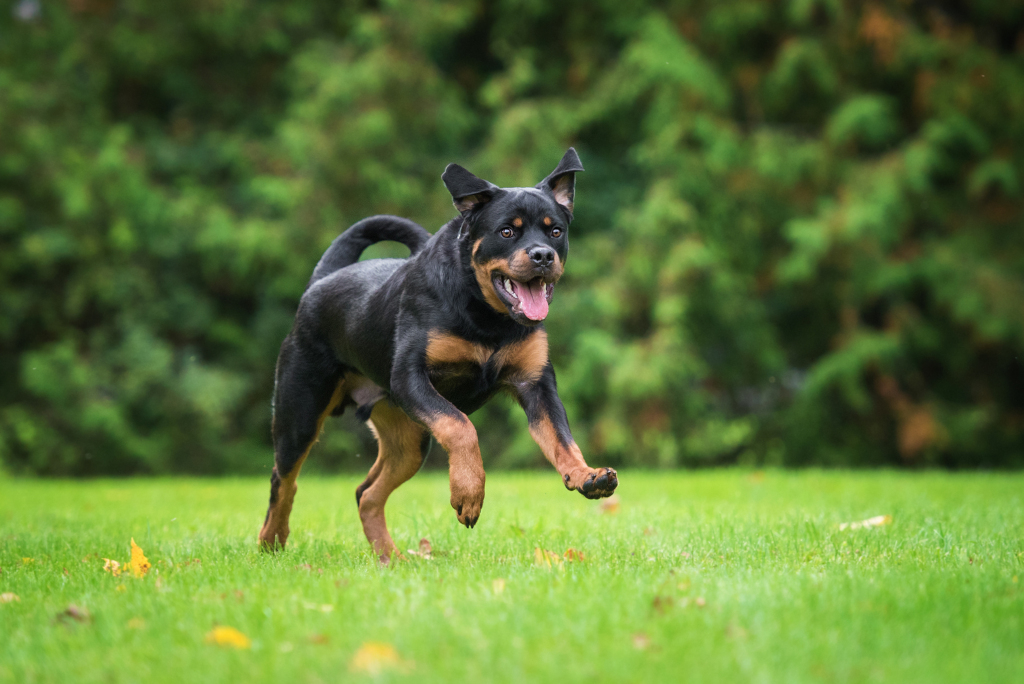
Contrary to common perception, the exercise needs for both German and American Rottweilers are remarkably similar, even though their temperaments differ.
German Rottweiler
Whether it’s for mental stimulation or physical exertion, German Rottweilers thrive on a balanced regimen of activity. Puzzle games, agility courses, and daily walks are excellent ways to keep them engaged.
American Rottweiler
Much like their German counterparts, the American Rottie also benefits from a consistent exercise routine. Engaging in activities like fetch, hiking, running, biking, or swimming can be just as rewarding for them.
You May Also Like: How to Train Your Dog to Run Alongside a Bicycle
| Key Differences | German Rottweiler | American Rottweiler |
|---|---|---|
| Energy Levels | Medium to high | Medium to high |
| Exercise Needs (Per Day) | At least 1 hour | At least 1 hour |
** Comparison Table for Energy Level and Exercise Needs
Training and Socialization: German Rottweiler vs. American Rottweiler

Training and socialization are key aspects to consider when choosing between a German and an American Rottweiler. Though similar in many respects, these variants do have unique qualities that might make one more suitable than the other for specific owners.
German Rottweiler
- Ease of Training:
The German Rottweiler’s calm temperament and keen intellect make it amenable to various types of training, including specialized tasks. This breed generally excels in obedience and advanced training protocols. - Social Behavior:
Loyalty to family is strong, but German Rottweilers can be somewhat reserved around strangers and other pets. Early socialization is particularly important for fostering good behavior, especially with children.
American Rottweiler
- Training Challenges:
While trainable, the American Rottweiler tends to be more stubborn, which may require a more patient and consistent training approach. - Social Skills:
These dogs are generally more social and more easily adapt to different environments. Early socialization can enhance their ability to get along well with children and other pets despite their stubborn streak.
You May Also Like: Unlock Your Dog’s Potential With These 7 Types Of Dog Training
| Key Differences | German Rottweiler | American Rottweiler |
|---|---|---|
| Ease of Training | Easier | More stubborn |
| Social Behavior | Reserved | Outgoing |
| Interaction with Children | Generally good | Generally good |
| Compatibility with Pets | Selective, needs socialization | More accepting |
** Comparison Table for Training and Socialization
Health and Lifespan
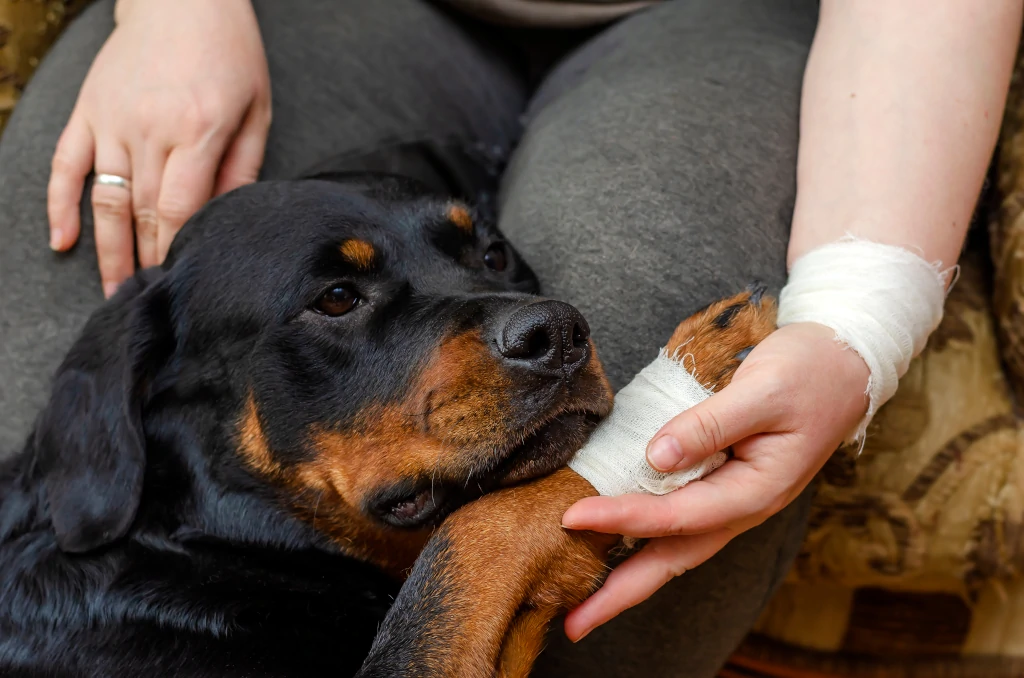
Lifespan is a common concern for potential Rottweiler owners. Both German and American Rottweilers typically share the same lifespan, averaging 9 to 10 years. However, it’s in the realm of common health issues where these two variants diverge due to breeding regulations.
German Rottweiler
While prone to similar health issues such as hip dysplasia, German Rottweilers have a slight advantage. The Allgemeiner Deutscher Rottweiler-Klub (ADRK) restricts the sale of puppies with known genetic health problems, and all breeding parents must be clinically healthy, contributing to a healthier gene pool.
American Rottweiler
The American Kennel Club (AKC) has fewer restrictions regarding breeding Rottweilers. This relative lack of regulation makes it more likely that American Rottweilers will encounter such issues over their lifespan.
You May Also Like: Why Do Dogs Bite Paws?
| Key Differences | German Rottweiler | American Rottweiler |
|---|---|---|
| Lifespan | 9 - 10 years | 9 - 10 years |
| Overall Health | Healthy | Healthy but are more prone to health issues |
** Comparison Table for Health and Lifespan
Nutrition and Diet
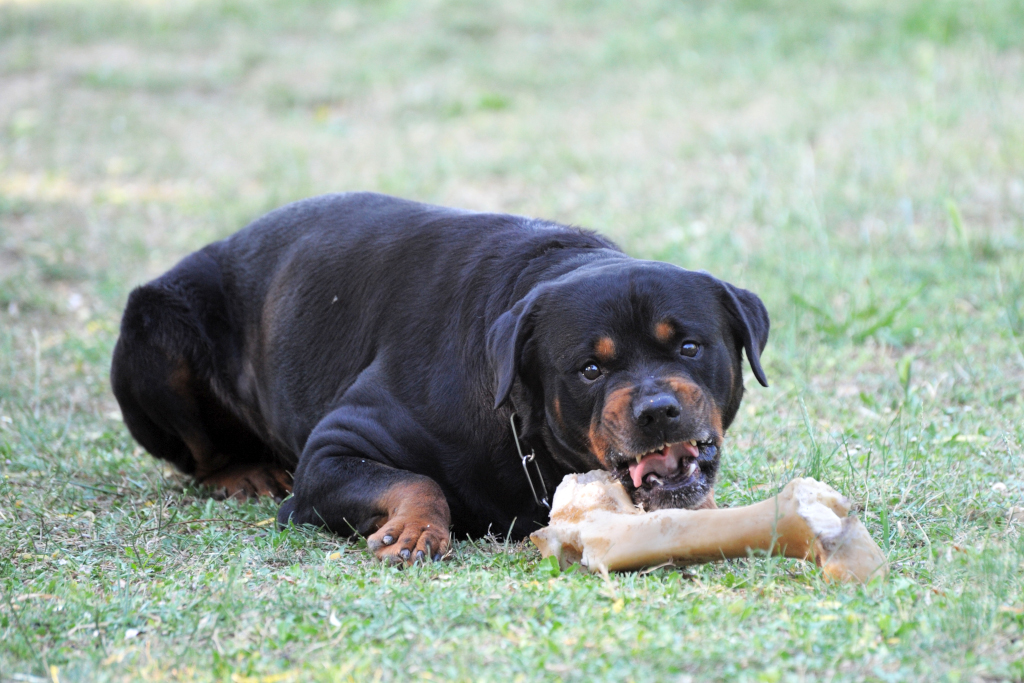
When discussing the nutritional needs of German and American Rottweilers, the requirements are fundamentally the same for both types. Rottweilers are large, muscular dogs that require balanced nutrition rich in protein, healthy fats, and essential nutrients for optimum health.
That said, the amount of food your Rottweiler needs will depend on various factors, such as age, size, and energy levels.
For instance, you’ll expect a larger, more active, working German Rottweiler to consume more food than a smaller, less active American Rottweiler to meet its higher energy needs.
Other factors like health conditions or specific dietary needs can also influence how much and what you should feed your dog.
You May Also Like: 14 Common Reasons Why Your Dog Won’t Eat
| Key Differences | German Rottweiler | American Rottweiler |
|---|---|---|
| Nutritional Composition | Identical | Identical |
| Food Quantity | May require more due to size and activity | May require less due to smaller size and lower activity |
** Comparison Table for Nutrition and Diet
Grooming Needs: American Rottweiler vs. German Rottweiler
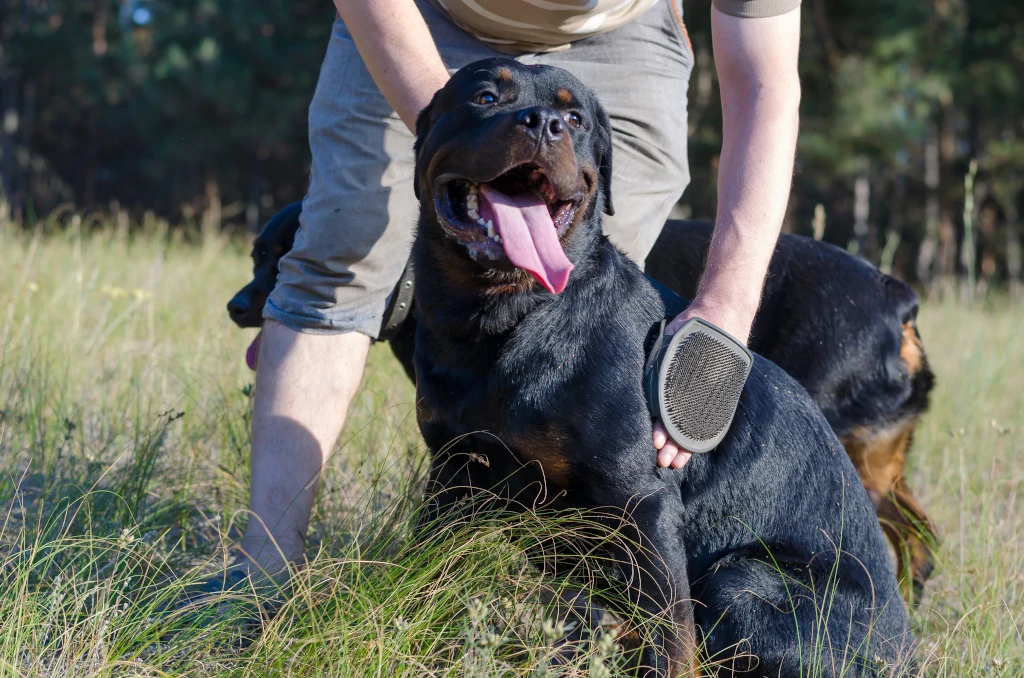
Regardless of the type—be it German or American—Rottweilers share the same grooming requirements.
These robust canines have a medium-length, coarse outer coat and a dense undercoat that requires regular maintenance for optimal health and appearance.
Both variants benefit from weekly brushing to remove loose hair and distribute natural oils, keeping the coat healthy, though more frequent brushing is required during periods of heavy shedding.
Additionally, regular nail trims, ear cleanings, and occasional baths should be part of your Rottweiler’s grooming regimen. Dental care is equally important for both types to prevent gum disease and other oral health issues.
You May Also Like: Best Toothpastes for Dogs
| Key Aspects | German Rottweiler | American Rottweiler |
|---|---|---|
| Coat Length | Medium | Medium |
| Shedding Amount | Moderate but slightly heavier in spring and fall | Moderate but slightly heavier in spring and fall |
| Brushing Frequency | Weekly but more frequently during the shedding season | Weekly but more frequently during the shedding season |
** Comparison Table for Grooming Needs
Puppy Price: German vs. American Rottweiler

When you’re contemplating adding a Rottweiler to your family, the financial commitment can be substantial, and it varies significantly depending on whether you opt for a German or an American variant.
American Rottweiler Costs
Generally, the cost of an American Rottweiler puppy ranges from $1,500 to $4,000.
Why Less Expensive: Beyond more lenient breeding regulations, the cost is often lower due to the availability of puppies across a wider range of breeders.
German Rottweiler Costs
On the other hand, the prices for a German Rottweiler start at $2,000 and can escalate to $10,000.
Why More Expensive: In addition to strict breeding standards by the ADRK, German Rottweilers often come with import costs (if bought from breeders in Germany), exhaustive health screenings, and sometimes even obedience training that begins at a young age, all contributing to the higher price.
| Key Aspects | German Rottweiler | American Rottweiler |
|---|---|---|
| Average Price | $1,500 - $4,000 | $2,000 - $10,000 |
** Comparison Table for Rottweiler Puppy Price
Which Rottie is Best For You? The German or American Rottweiler?
Choosing between a German and an American Rottweiler involves more than picking a pup based on aesthetics or price. This decision will influence your day-to-day life for many years, so it’s crucial to align your choice with your specific needs and goals for pet ownership.
Why Choose an American Rottweiler?
- If you’re a pet owner who values a relaxed and go-with-the-flow temperament in a dog, the American Rottweiler could be your perfect match.
- Budget-conscious buyers will also appreciate that American Rotties are generally more affordable.
Why Choose a German Rottweiler?
- If you aspire to enter dog competitions, whether that’s obedience, agility, herding, or carting, a German Rottweiler’s more disciplined and focused nature would be beneficial.
- Those looking for a more alert and responsive watchdog will also find these traits more pronounced in the German Rottie.
| Key Attributes | German Rottweiler | American Rottweiler |
|---|---|---|
| Temperamental Leanings | Relaxed and easygoing | Disciplined and alert |
| Affordability | More budget-friendly | Often comes at a premium |
| Best Suited for | Casual pet owners | Specialized roles and competitions |
Key Takeaway: The American Rottweiler is well-suited for those seeking a Rottie that fits easily into a laid-back lifestyle and doesn't break the bank. In contrast, the German Rottweiler is better matched with those wanting a Rottie with a disciplined disposition, be it for competition or for enhanced household security.
Frequently Asked Questions
Q1: Which breed is stronger: the German Rottweiler or the American Rottweiler?
A: In terms of raw physical strength, both the German and American Rottweiler are quite formidable, owing much to their similar build and weight range. However, German Rottweilers often come across as stronger because they’re generally more disciplined and focused. This mental strength, combined with their robust build, makes them particularly reliable in tasks requiring physical force, agility, and focus. So, while both varieties boast considerable physical prowess, the German Rottweiler’s disciplined temperament often gives them the edge in situations where strength is measured not just in muscle but in reliability and control as well.
Q2: What are the three types of Rottweiler?
A: The three commonly referred to types of Rottweiler are the German Rottweiler, American Rottweiler, and Roman Rottweiler. However, it’s important to note that the Roman Rottweiler is not a recognized classification by major kennel clubs and is often considered a marketing term.
Q3: Which Rottweiler breed is the biggest?
A: The biggest Rottweiler is often purported to be the “Roman Rottweiler,” a term used to describe a Rottweiler that is larger than the standard. However, this isn’t a recognized official subtype by the major kennel clubs. Among the acknowledged types, German Rottweilers tend to be larger and more robust than their American counterparts.

